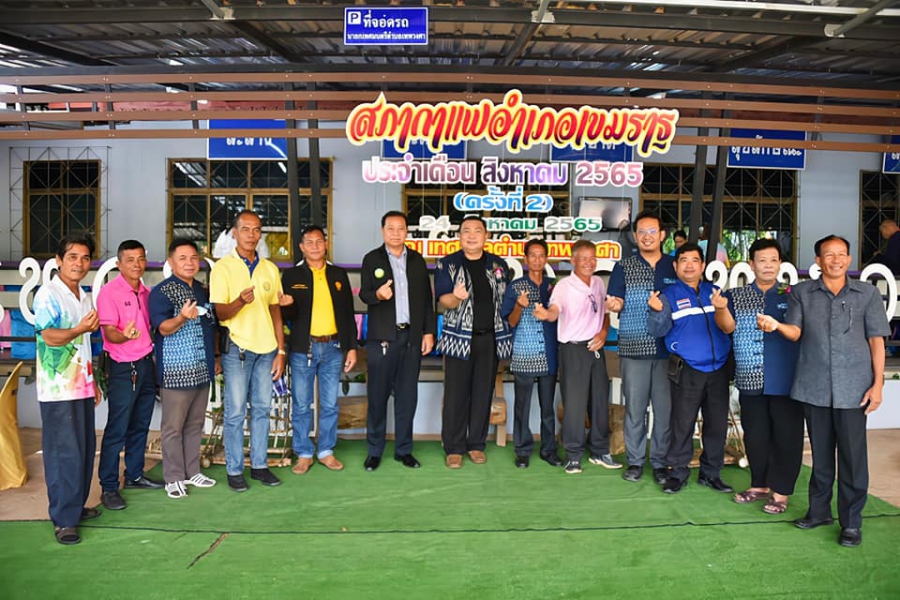งานประเพณีวันออกพรรษา ไหลกระทงสาย เรือไฟโบราณฮิมของ เมืองเขมราษฎร์ธานี ชมกระทงสาย 2,700 ดวง ฉลองเขมราษฎร์ธานี207ปี ระหว่างวันที่ 10-12 ตุลาคม 2565
วันพุธ, 19 ตุลาคม 2565 10:40เทศบาลตำบลเทพวงศา บริหารงานโดยนายอลงกต แสวงสุข นายกเทศมนตรีตำบลเทพวงศา จัดงานประเพณีวันออกพรรษา ไหลกระทงสาย เรือไฟโบราณฮิมของ เมืองเขมราษฎร์ธานี ชมกระทงสาย 2,700 ดวง ฉลองเขมราษฎร์ธานี207ปี ซึ่งจัดกิจกรรมต่างๆมากมาย ระหว่างวันที่ 10-12 ตุลาคม 2565
https://www.thepwongsa.go.th/index.php/news/activity-news/item/958-say?start=230#sigProGalleria660b95e492
2001 ความคิดเห็น
-
ลิงค์ความคิดเห็น

Ищете альтернативу KRAKEN?
วันอาทิตย์, 19 ตุลาคม 2568 06:34 โดย : krakrMop
Вот ещё вариант: https://krakr.cc -
ลิงค์ความคิดเห็น

Ищете актуальные адреса для входа на KRAKEN
วันอาทิตย์, 19 ตุลาคม 2568 04:44 โดย : knto
Проверьте https://2kn.to .
Здесь собраны только актуальные KRAKEN ссылки.
Если один адрес KRAKEN не работает, попробуйте https://2kn.to
кракен вход ссылки -
ลิงค์ความคิดเห็น

keyword.
วันอาทิตย์, 19 ตุลาคม 2568 04:16 โดย : krakrMop
Сохраняйте рабочие адреса KRAKEN и проверяйте их перед входом. -
ลิงค์ความคิดเห็น

Astronomers have observed a planet that in some ways behaves more like a star — including a massive growth spurt unlike anything witnessed before in a free-floating planet.
วันอาทิตย์, 19 ตุลาคม 2568 02:34 โดย : AdrianEmuth
[url=https://ms-stroy.ru/]строительство коттеджей в подмосковье[/url]
The rogue planet, which does not orbit any star, is called Cha 1107-7626 and is outside of our solar system, 620 light-years from Earth in the Chamaeleon constellation. A single light-year, or the distance light travels in one year, is equal to 5.88 trillion miles (9.46 trillion kilometers).
The planet has a mass five to 10 times that of Jupiter, the largest planet in our solar system. And it’s getting bigger every second, according to new research published Thursday in The Astrophysical Journal Letters.
Estimated to be 1 million to 2 million years old, Cha 1107-7626 is still forming, said study coauthor Aleks Scholz, an astronomer at the University of St. Andrews in Scotland. It may sound old, but astronomically speaking, the planet is in its infancy. By contrast, the planets in our solar system are about 4.5 billion years old.
https://ms-stroy.ru/ipoteka-na-stroitelstvo-doma/
построить коттедж под ключ недорого
Cha 1107-7626 is surrounded by a disk of gas and dust, which constantly falls onto the planet and accumulates during a process that astronomers call accretion. But the rate at which the young planet is growing varies, the study authors said.
Observations with the European Southern Observatory’s Very Large Telescope in Chile’s Atacama Desert, along with follow-up views conducted by the James Webb Space Telescope, showed that the planet is adding material about eight times faster than a few months earlier and gobbling up gas and dust at a record rate of 6.6 billion tons (6 billion metric tons) per second.
Related article
The Earth-size exoplanet TRAPPIST-1 e, depicted at the lower right, is silhouetted as it passes in front of its flaring host star in this artist’s concept of the TRAPPIST-1 system.
Earth-like exoplanet could be habitable, and astronomers may know soon
The unusual burst of activity is the strongest growth rate ever recorded for a planet of any kind, said lead study author Victor Almendros-Abad, an astronomer at the Palermo Astronomical Observatory of the National Institute for Astrophysics in Italy, and is shedding light on the tumultuous formation and evolution of planets.
“We’ve caught this newborn rogue planet in the act of gobbling up stuff at a furious pace,” said senior coauthor Ray Jayawardhana, provost and professor of physics and astronomy at Johns Hopkins University, in a statement.
“Monitoring its behavior over the past few months, with two of the most powerful telescopes on the ground and in space, we have captured a rare glimpse into the baby phase of isolated objects not much heftier than Jupiter. Their infancy appears to be much more tumultuous than we had realized.” -
ลิงค์ความคิดเห็น

Коротко о том, как попасть на зеркало KRAKEN :
วันอาทิตย์, 19 ตุลาคม 2568 02:22 โดย : knto
— Откройте браузер.
— Введите https://2kn.to
— Если KRAKEN не открывается, возьмите резервный адрес из списка: телеграм бот кракен. -
ลิงค์ความคิดเห็น

Проблема с доступом на сайт KRAKEN?
วันอาทิตย์, 19 ตุลาคม 2568 01:49 โดย : krakrMop
Очищайте кэш и пробуйте резервную ссылку KRAKEN: https://krakr.cc
krakr -
ลิงค์ความคิดเห็น

Профессиональный ремонт подъемника [url=https://www.podemniki-st.ru/]http://podemniki-st.ru[/url]ремонт строительного подъемника гарантирует безопасность и долговечность вашего оборудования.
วันอาทิตย์, 19 ตุลาคม 2568 00:16 โดย : remont_llSt
Не стоит забывать, что ремонт требует как финансовых, так и временных вложений. -
ลิงค์ความคิดเห็น

Хотите попасть на страницу проекта KRAKEN быстро?
วันเสาร์, 18 ตุลาคม 2568 23:48 โดย : krakrMop
Если нужен мобильный вход, ищите мобильную ссылку: https://krakr.cc
Мы обновляем адреса по мере необходимости.
сайт кракен даркнет -
ลิงค์ความคิดเห็น

Astronomers first discovered Cha 1107-7626 in 2008, and since then, they have observed it with different telescopes to learn more about how the infant planet evolves, as well as to study its surroundings.
วันเสาร์, 18 ตุลาคม 2568 23:24 โดย : JustinAdept
[url=https://tlk-triga.ru/tarif/]рассчитать грузоперевозки[/url]
The research team observed the planet with Webb in 2024, making a clear detection of the surrounding disk. Next, the researchers studied it using the X-shooter spectrograph on the Very Large Telescope, which can capture different wavelengths of light emitted by an object ranging from ultraviolet to near-infrared.
The observations detected a puzzling event as the planet transitioned from a steady accretion rate in April and May to a burst of growth between June and August.
https://tlk-triga.ru/negabarit/
аренда трала москва цена
“I fully expected that this is a short-term event, because those are much more common,” Scholz said. “When the burst kept going through July and August, I was absolutely stunned.”
Follow-up observations made using the Webb telescope also showed that the chemistry of the disk had changed. Water vapor, present during the growth spurt, wasn’t in the disk before. Webb is the only telescope capable of capturing such detailed changes in the environment for such a faint object, Scholz said. Prior to this research, astronomers had only ever seen the chemistry of a disk change around a star, but not around a planet.
Comparing observations from before and during the event showed that magnetic activity seems to be the main driver behind how much gas and dust is falling on the planet — a phenomenon typically associated with stars as they grow.
But the new observations suggest that objects with much less mass than stars — the rogue world is less than 1% the mass of our sun — can have strong magnetic fields capable of driving the growth of the object, according to the study authors.
An infrared image taken with the Visible and Infrared Telescope for Astronomy shows Cha 1107-7626, a dot located in the center.
An infrared image taken with the Visible and Infrared Telescope for Astronomy shows Cha 1107-7626, a dot located in the center. ESO/Meingast et al.
A planet that acts like a star
The origin of rogue planets remains murky. It’s possible they are planets that are kicked out of orbit around stars due to the gravitational influence of other objects. Or perhaps they are the lowest-mass objects that happen to form like stars. For Cha 1107-7626, astronomers said they think it’s the latter.
“This object most likely formed in a way similar to stars — from the collapse and fragmentation of a molecular cloud,” Scholz said.
A molecular cloud is a massive, cold cloud of gas and dust that can stretch for hundreds of light-years, according to NASA.
“We’re struck by quite how much the infancy of free-floating planetary-mass objects resembles that of stars like the Sun,” Jayawardhana said in a statement. “Our new findings underscore that similarity, and imply that some objects comparable to giant planets form the way stars do, from contracting clouds of gas and dust accompanied by disks of their own, and they go through growth episodes just like newborn stars.” -
ลิงค์ความคิดเห็น

Коротко о том, как попасть на зеркало KRAKEN :
วันเสาร์, 18 ตุลาคม 2568 21:53 โดย : knto
— Откройте браузер.
— Введите https://2kn.to
— Если KRAKEN не открывается, возьмите резервный адрес из списка: кракен тор.
แสดงความคิดเห็น
***กรุณาแสดงความคิดเห็น ด้วยความสุภาพ เคารพต่อสิทธิของผู้อื่น ไม่ละเมิดต่อกฎหมาย และศีลธรรมอันดีของสังคม


